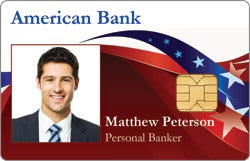- Home
- ID Card Printers
- IDP Printers
- SOLID-310SE
SOLID-310SE
Shop IDP SOLID-310SE ID Card Printers
Available with your choice of single- or dual-sided direct-to-card printing, the SOLID-310SE offers flexibility at a low cost. In addition, every SOLID-310SE printer comes with a free YMCKO 100-print color ribbon and 100 plastic PVC ID cards – a $60+ value! Plus, it's backed by an industry-leading, 3-year warranty.

Have Questions about IDP SOLID-310SE Card Printers? We Have Answers!
What are the Main Features and Benefits of the IDP SOLID-310SE?
IDP SOLID-310SE ID card printers offer convenience, flexibility and maximum efficiency, all at a low-cost. In addition, unlike other cheap printers, the SOLID-310SE exclusively offers a free YMCKO 100-print color ribbon and 100 plastic PVC ID cards – a $60+ value . Designed for low volume, affordable card printing applications, IDP SOLID-310SE printers are the perfect solution for access control, government ID, banking cards, healthcare, and more!
SOLID-310SE printers offer a number of user-friendly features including:
- Single- or dual-sided printing capabilities
- Enhanced data security via data encryption, SSL Protocol, and PC authentication
- An industry-leading 3-year warranty with printer exchange program
- Dye-sublimation printing for vivid images and thermal resin printing for sharp black text and barcodes
- Rewrite printing option to easily and inexpensively reuse temporary ID cards such as visitor badges
- A standard USB connection with an Ethernet option for printing over a network
- Encoding options for writing electronic data to your cards
Should I Choose the Single-Sided SOLID-310SE or the Dual-Sided SOLID-310SE?
It depends on how much information you need to put on your cards. For example, if you will only be placing the cardholder's photo and name on your cards, the single-sided SOLID-310SE may be ideal for you. However, if you need to place more information on your cards, we recommend the dual-sided SOLID-310SE so that you can print to both sides of the card in one, simple process.
Many customers ask if it is possible to print on both sides of the card with a single-sided printer by manually flipping the cards and sending them back through the printer. While technically it is possible, it's not recommended. Printing on both sides of the card with a single-sided SOLID-310SE printer will expose the printhead to dust, debris, and oil from your fingertips, which can cause expensive printhead damage. Plus, damage to a printhead from non-standard use will void warranty coverage, costing you more in the long run.
If you will be creating cards with limited cardholder information, choose the single-sided IDP SOLID-310SE.
If you will be printing more information on your cards and want the ability to print on both sides of the card, choose the dual-sided IDP SOLID-310SE.
I Need to be Able to Store or Access Data on My Cards. What are My Card Encoding Options?
Barcode Printing

There are three primary ways to access or store data on a card: a barcode, magnetic stripe, or smart card. If you do not have an encoding single-sided ID card printer or software with encoding capabilities, you can still use a barcode to access data on a card. The data is stored electronically in a computer, not within the barcode.
Requirements: All single-sided card printers are capable of adding a 1-D or 2-D barcode to a plastic card. You will simply need a barcode scanner connected to a computer that contains the barcode's data to read the barcode.
Magnetic Stripe Encoding

While a barcode's information is kept in a computer, information within a magnetic stripe is stored within the stripe of the card. When used for access control, for example, each card holds data that will unlock preprogrammed doors. Simply swipe the card and, if you are a validated user of that door, it will unlock.
There are two types of magnetic stripe cards:
High Coercivity (HiCo) magnetic stripe cards are harder to erase, and are used in applications where cards are frequently used or need to have a long life. HiCo stripes are resistant to damage from most magnets or magnetic fields and therefore are most often used for access control, timed attendance, and gift cards.
Low Coercivity (LoCo) magnetic stripe cards require a lower amount of energy to record and are easier to erase. LoCo stripes can be damaged by even a brief contact with a magnetic field. With this, LoCo cards are typically used for applications where the card is only used for a short time, such as hotel room keys.
Requirements: In order to use magnetic stripe cards, you will need an encoding single-sided ID card printer and mid-level or fully-featured ID software.
Smart Card and Proximity Card Encoding

Data is stored within the smart card components, similar to a magnetic stripe card. A smart card can hold up to 100 times more data than a magnetic stripe and offers added functionality. It can be reconfigured to add, erase, or edit hosted data. They can be categorized into two categories:
A contact smart card has an integrated chip. As the name implies, a contact smart card must come into direct contact with the reader in order to be read.
A contactless smart card has a chip and an antenna. In order to be read, it needs to come within a specified distance to the reader (varies by reader), but doesn't need to make direct contact.
Note: Proximity cards are similar to contactless smart cards, but there are important differences. Proximity cards come pre-programmed, so do not need to be encoded. Some single-sided card printers can read/verify data that has been written to a proximity card, but data on most* proximity cards cannot be added, erased, or edited.
Requirements: In order to use a contact or contactless smart card, you'll need a smart card encoding single-sided printer and fully-featured ID software. When ordering the printer, you'll need to specify whether you require contact or contactless encoding.
*Some cards, such as iClass cards, include non-editable, pre-programmed proximity data and a smart chip for encoding your own data.

